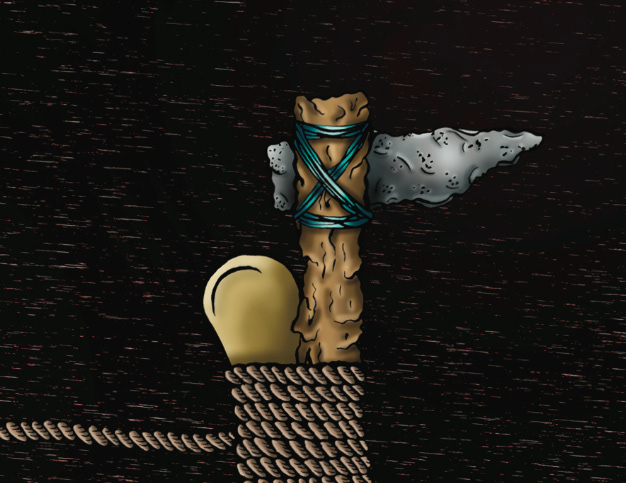This is an alternative book cover designed for
the book "Things Fall Apart" by Chinua Achebe.

The final artwork has taken the symbolic approach. The book design has intertwined various symbolic elements to create a type of symbolic pun for the storyline of the book.
One of the dominant themes in the book is the struggle between change and tradition and the tension that comes with change. The main image is two different axes (one being a new very modern axe and the other being an old traditional adze axe) being held together with the tension of a rope. The ancient adze axe represents the traditional Umuofia tribe of the Igbo people, while the new modern axe represents the white Christian people who have descended into the area. The rope coiled around the two axes are trying to hold the two completely different cultures together, however, this causes destruction and anger. The ancient adze axe is seen to be used and weathered. The new modern axe is seen to be disintegrating. This represents the fact that languages and cultures are now falling apart and are struggling to exist as one coherent movement.
A famous quote from the book “He has put a knife on the things that held us together and we have fallen apart...” also links in with the final image in the way that the “knife” is the new modern axe coming into contact with the ancient cultures that exist in the village. This ultimately creates a tension and have started making everything fall apart. It is also representative of Okonkwo's pride that he tries so hard to keep together but ultimately commits suicide (which is considered an extreme sin against the oracle and ancestors).
The crack on the new modern axe is cracking in the shape of a tree. The tree is symbolic of a family tree of the Umuofia tribe of the Igbo people. When this new modern axe (white Christian community) interacts with the tribe, some of the members becoming imprinted with the Christian ways but some members rebel and want to fight against it, causing cracks in the system and so it begins to fragment (as seen with the falling axe splinters).
The splinters are intermingled with actual leaves from a fallen tree. These leaves are symbolic of the people who have fallen (either given up their traditions and followed the Christians or who have fallen into anger). Either way, things have fallen apart.
The coiled rope that is trying to hold the two different axes together extends to become a noose of a rope used to hang someone on the back of the book cover. This creates an interesting extended image over the entire cover and helps to link up the front and back covers. It is representative of the deaths that occur throughout the book and the fact that Okonkwo finally hangs himself at the end of the book. When the viewer looks at the book's front cover, they don’t initially see the hang rope but this shows that due to the tension of the two cultures (two axes), a hidden death lurks later on.
The butterflies flying up from the fallen leaves symbolise the fact that even though great things have fallen, there is still hope to grow and mature and fly away. This depends on the person though. In the story, Okonknwo can be seen as a mature butterfly, growing up from his past by the way he insists on not becoming weak like his father. However, in the end his character fails himself and he choses death over life.
This choice of death or life can be seen on the cover where the butterfly intersects with the noose of the hanging rope. Initially Okonkwo chose a better life but he ultimately chose death at the end. His pride was too great and in his mind he died a hero.
The original sketches were painted with black ink...

The final design was coloured and finished off in
Adobe Photoshop and Adobe Illustrator...






“He has put a knife on the things that held
us together and we have fallen apart...”


